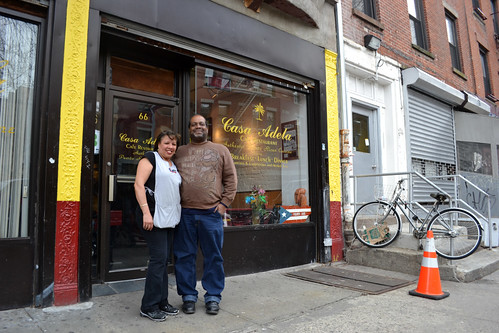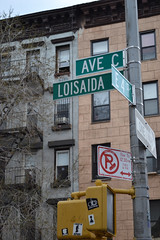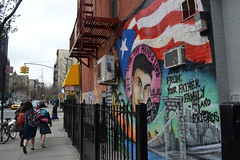 Ian Duncan Luis Rivera and Maritza Lopez outside their Puerto Rican restaurant on Loisaida Avenue. For the first time in 30 years, the area east of Avenue B is less than half Hispanic.
Ian Duncan Luis Rivera and Maritza Lopez outside their Puerto Rican restaurant on Loisaida Avenue. For the first time in 30 years, the area east of Avenue B is less than half Hispanic.The 2010 Census offers a portrait of an East Village that is more populous and less diverse. For the first time since the 1980’s, the area east of Avenue B is less than half Hispanic and the number of white residents in the area has surged.
The total population of the East Village now stands at 73,676, according to the figures, up 5.7 percent over the decade. White people now make up more than half of the population of the neighborhood, while Hispanics make up less than one quarter. The number of blacks in the neighborhood dipped by 5 percent.
East of Avenue B — the census splits records down that street — the trend is even more dramatic. The Hispanic population there fell by a little more than 10 percent, while the white population in that part of the neighborhood jumped almost 38 percent.
Claudio Remeseira, founder and director of the Hispanic New York Project at Columbia University, said the trend illustrates a number of changes taking place to the neighborhood, including gentrification, the upward mobility of some Puerto Ricans, and the decision of others to leave the city entirely.
“We are used to talking about poverty,” Mr. Remeseira added, “we tend to forget there is also upward mobility of Puerto Ricans and Domicans.”
 Ian Duncan The neighborhood’s relative Hispanic population peaked in 1980, with 68.5 percent. Since then, the figures show a downward trend.
Ian Duncan The neighborhood’s relative Hispanic population peaked in 1980, with 68.5 percent. Since then, the figures show a downward trend.Yet the picture is complex and Mr. Remeseira described persistent poverty among Hispanics as “frustrating.” “The fact that we talk about Hispanics and Latinos as a single group can be confusing,” he added.
While the figures hint at the gentrification of the neighborhood, the census bureau has not yet released data for income, education and other socioeconomic indicators. Until then, Mr. Remeseira said, any conclusions must be tentative.
Luis Rivera, the owner of Casa Adela, a Puerto Rican restaurant on Avenue C between East Fifth and East Sixth Streets, said he has seen a change in the type of customer he serves. “More Americans move into the neighborhood,” he said, “but they don’t stay long.”
Just as many of the neighborhood’s former Hispanic residents have moved out to Queens in search of more space, newcomers also feel the pressure of high rents, according to Mr. Rivera. Asked about rents for businesses, Mr. Rivera just shook his head, but said he has no plans to leave the area.
Mr. Rivera’s mother moved to the United States from Puerto Rico in the early 1970’s and started Casa Adela in 1976. Despite the changes in the neighborhood, Mr. Rivera said he has kept the menu traditional. “That’s what we know how to cook,” he said.
Data from previous censuses show the number of Hispanic residents remained relatively steady between 1960 and 1990. But between 1970 and 1980 the total population of the Loisaida collapsed by 40 percent, and the vast majority of those who remained were Hispanic. The relative population peaked in 1980, when 68.5 percent of residents were Hispanic. Since then, the figures show a downward trend.
The Loisaida — the name is a Spanish form of Lower East Side — has seen waves of Puerto Rican immigration since the late 19th century. By 1980’s the artier designation of Alphabet City began to compete with the Loisaida, but despite gentrification and rising rents, the area has maintained much of its distinct character. Walking down Avenue C today, though, you are as likely to find a trendy bar as an old-fashioned bodega.
Citywide, Hispanics were the second-fastest growing population group after Asians, but that growth came in the outer boroughs.
Among the fastest growing parts of the neighborhood was the triangle between Fourth and Third Avenues, which was up 40.4 percent. Andrew Berman, executive director of the Greenwich Village Society for Historic Preservation, wrote on the organization’s blog suggesting that the construction of new NYU dorms is the source of the growth.
About 1,892 new housing units were added in the neighborhood. Only 5.5 percent of the units are vacant, despite the number of vacant units increasing by almost 40 percent.
Slow population growth across the city surprised analysts when figures first emerged in March. New York’s population grew by 2.1 percent, which was below yearly estimates produced by the census bureau. That could mean the city losing out when federal funds are allocated and Mayor Michael Bloomberg will formally contest the figures. In a speech he argued that immigrants in Brooklyn and Queens were systematically under-counted.
Join the conversation: How have you seen the East Village change over the last decade?




